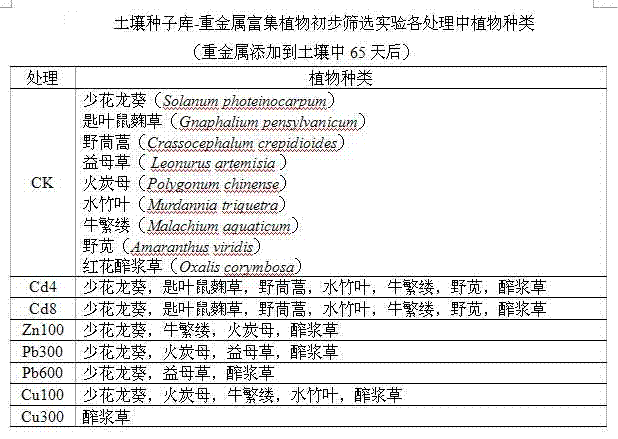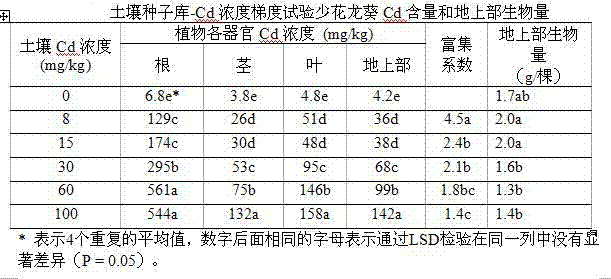Method for searching heavy metal hyper accumulator
A technology for hyper-accumulating plants and heavy metals, applied in the field of finding hyper-accumulating plants for heavy metals, can solve the problems of ignoring plants with repair potential and limited plant species, and achieve the effect of simple and easy operation and rich plant species
- Summary
- Abstract
- Description
- Claims
- Application Information
AI Technical Summary
Problems solved by technology
Method used
Image
Examples
Embodiment 1
[0017] Example 1: Soil Seed Bank - Preliminary Screening Experiment of Heavy Metal Enrichment Plants
[0018] The experiment was carried out in the greenhouse of South China Botanical Garden in Guangzhou. Garden soil was picked from the botanical garden, dried in the sun, passed through a 1 cm sieve, and filled into pots (¢=30 cm, H=28 cm), each pot was filled with 12.5 kg of soil, and CdCl was added to the soil 2 , ZnSO 4 7H2O, Pb(NO 3 ) 2 、CuSO 4 ·5H 2 O solution, the concentration is set as: Cd: 4 mg / kg, 8 mg / kg, Zn: 100 mg / kg, Pb: 300 mg / kg, 600 mg / kg, Cu: 100 mg / kg, 300 mg / kg, The treatment without adding heavy metals was used as the control, with a total of 8 treatments without repetition. Since there are plant seeds in the recovered soil, there is no need to sow or transplant seedlings in addition. 65 days after adding the heavy metal solution, identify and record the plant species in the pot ( figure 1 ), among all the plants, it was found that Solanum nigrum p...
Embodiment 2
[0022] Embodiment Two: Soil Seed Bank—Cd Concentration Gradient Test
[0023] Through the above-mentioned preliminary experiment (Example 1), it was found that Solanum nigrum has strong tolerance to Cd, and can enrich a higher content of Cd ( figure 2 ). In order to further investigate the tolerance and absorption capacity of Solanum nigrum to Cd, a Cd concentration gradient experiment was designed to test its tolerance and enrichment characteristics to Cd.
[0024] The experiment was carried out in the greenhouse of South China Botanical Garden in Guangzhou. Use the same vegetable garden soil as the above screening experiment, put in pots (¢=16 cm, H=14 cm), 2 kg per pot. There is no need to sow or transplant seedlings since the seeds of the nightshade are already in the soil. Adding CdCl to the soil 2 solution, Cd concentrations were 0, 8, 15, 30, 60 and 100 mg / kg, respectively, a total of 6 treatments, repeated 4 times. Water according to the water needs of the plants...
Embodiment 3
[0028] Embodiment three: transplant seedlings-Cd concentration gradient test:
[0029] The experiment was carried out in the greenhouse of South China Botanical Garden in Guangzhou. Use the same vegetable garden soil as the above screening experiment, put in pots (¢=30 cm, H=28 cm), fill each pot with 12.5 kg of soil, and then add different concentrations of CdCl to the soil 2 solution. Add according to the soil Cd concentration of 0, 8, 15, 30, 60, 100 mg / kg, a total of 6 concentration treatments, repeated 4 times. After balancing for 1 month, pour out the soil in each pot and mix evenly, so that the heavy metals and nutrients in the soil are evenly distributed, and then put them into the pots. Transplant 5 cm high (after 10 days of seed germination) Solanum nigrum seedlings into pots, 3 strong seedlings per pot. During the growth period, the plants were watered according to the water demand of the plants, and the plants were harvested 60 days after transplanting the seedl...
PUM
 Login to View More
Login to View More Abstract
Description
Claims
Application Information
 Login to View More
Login to View More - Generate Ideas
- Intellectual Property
- Life Sciences
- Materials
- Tech Scout
- Unparalleled Data Quality
- Higher Quality Content
- 60% Fewer Hallucinations
Browse by: Latest US Patents, China's latest patents, Technical Efficacy Thesaurus, Application Domain, Technology Topic, Popular Technical Reports.
© 2025 PatSnap. All rights reserved.Legal|Privacy policy|Modern Slavery Act Transparency Statement|Sitemap|About US| Contact US: help@patsnap.com



